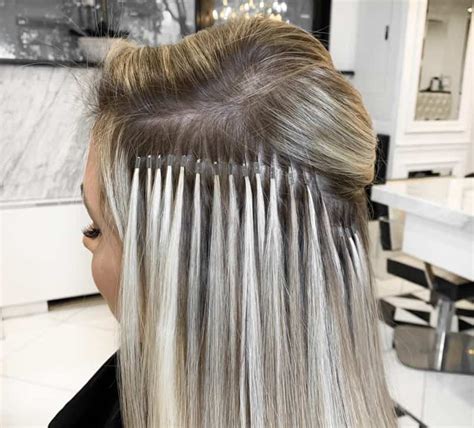Introduction
Hair extensions have become increasingly popular as a way to achieve your desired hair length, volume, and style. With various materials, lengths, and attachment methods available, choosing the most recommended hair extensions can be overwhelming. This guide will provide you with a comprehensive overview of the most popular and highly-rated hair extension types, their benefits, drawbacks, and expert recommendations.

Types of Hair Extensions
Clip-ins
-
Benefits:
- Easy to apply and remove
- Affordable
- Versatile for different hairstyles
-
Drawbacks:
- Visible clips if not applied correctly
- Limited longevity (can last for several wears)
Tape-ins
-
Benefits:
- Thin, inconspicuous adhesive bonds
- Long-lasting (can last for 4-8 weeks)
- Creates natural-looking volume
-
Drawbacks:
- Requires professional application and removal
- Can damage hair if not applied or removed properly
Keratin Fusion
-
Benefits:
- Most durable (can last for 3-6 months)
- Creates seamless blends with natural hair
- Can be heat-styled
-
Drawbacks:
- Expensive
- Requires professional application and removal
- Can damage hair if not applied or removed properly
Weaves
-
Benefits:
- Versatile for different hair textures and styles
- Long-lasting (can last for 3-6 months)
- Adds significant volume and length
-
Drawbacks:
- Time-consuming application process
- Requires regular maintenance and re-tightening
- Can be uncomfortable due to tension on hair
Choosing the Right Hair Extensions
The best hair extensions for you will depend on your specific needs and preferences. Consider the following factors:
Desired Length and Volume
Determine the desired length and volume you want to achieve. Clip-ins and tape-ins are suitable for adding volume and length, while weaves and fusion extensions offer more substantial transformations.
Hair Type and Texture
Match the hair extensions to your natural hair type and texture. This ensures a seamless blend and prevents damage to your hair.
Lifestyle and Maintenance
Consider your lifestyle and maintenance routine when selecting hair extensions. Clip-ins and tape-ins are easy to remove and reapply, making them ideal for occasional use. Weaves and fusion extensions require more maintenance and professional application.
Budget and Expertise
Hair extensions can vary significantly in price. Consider your budget and whether you have the expertise to apply and maintain extensions yourself or if you need professional assistance.
Expert Recommendations
According to the American Academy of Dermatology, the safest and most recommended hair extensions are clip-ins or tape-ins, which are less likely to cause damage to natural hair. For long-term use and seamless integration, keratin fusion extensions are favored by hairstylists.
Innovative Applications of Hair Extensions
Volume Enhancers
Hair extensions can be used to create a fuller, more voluminous look. They can be applied to the top or crown of the head to enhance volume without adding significant length.
Color Corrections
Hair extensions offer a non-permanent solution for color corrections. They can be added to add highlights, lowlights, or a pop of color without committing to a full dye job.
Protective Styles
Hair extensions can protect natural hair from damage caused by heat styling, chemical treatments, and environmental factors. They can be braided or sewn into protective styles that minimize breakage and promote hair growth.
Comparison Table: Types of Hair Extensions
| Type | Benefits | Drawbacks |
|---|---|---|
| Clip-ins | Easy to apply, affordable, versatile | Visible clips, limited longevity |
| Tape-ins | Thin bonds, long-lasting, natural volume | Professional application, can damage hair |
| Keratin Fusion | Most durable, seamless blends, heat-stylable | Expensive, requires professional application, can damage hair |
| Weaves | Versatile, long-lasting, adds volume | Time-consuming application, requires maintenance, can be uncomfortable |
Comparison Table: Hair Texture and Extension Match
| Natural Hair Texture | Recommended Extension Texture |
|---|---|
| Straight | Straight |
| Wavy | Wavy or Curly |
| Curly | Curly or Coily |
| Coily | Coily |
Comparison Table: Maintenance and Longevity
| Type | Maintenance | Longevity |
|---|---|---|
| Clip-ins | Remove and reapply as needed | Several wears |
| Tape-ins | Re-tape every 4-8 weeks | 4-8 weeks |
| Keratin Fusion | Re-adjust and re-tip every 3-6 months | 3-6 months |
| Weaves | Re-tighten and braid every 3-6 weeks | 3-6 months |
Comparison Table: Cost and Application
| Type | Cost | Application |
|---|---|---|
| Clip-ins | $50-$200 | Self-application |
| Tape-ins | $200-$500 | Professional application |
| Keratin Fusion | $500-$1,000 | Professional application |
| Weaves | $300-$800 | Professional application |
Conclusion
Choosing the most recommended hair extensions requires careful consideration of your hair type, desired outcome, and lifestyle. By understanding the different types of extensions, their benefits, and drawbacks, you can make an informed decision that meets your specific needs and preferences. Remember to consult with a professional hairstylist if you have any doubts or require professional application.
